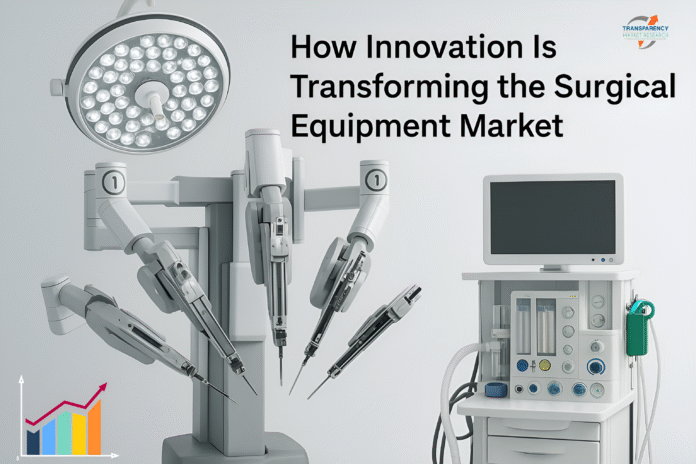In the heart of all busy operating rooms, surgical instrumentation is necessary – not only to facilitate processes, but also to save life. From the simple scalpel and masks of the past, to today’s advanced robot systems and electrical units with high tector, surgical equipment has traveled far from its old roots. Today, they are intersecting with innovation, accurate engineering and life -saving techniques.
A market in rapid development
The surgical equipment market around the world has seen outstanding changes with increasing need for health care, technological progress and change of surgical practice over the past decade. The size of the market stood at US$ 19.2 billion as of 2024. With growing focus on minimally invasive surgery, digital surgery, and better patient outcomes, the market is projected to grow to US$ 50.1 billion by 2035, achieving a CAGR of 9.1% during 2025-2035.
This expansion is no surprise when you look at the changing face of global healthcare. From aging populations and rising levels of surgical activity, to the spread of ambulatory surgical centers (ASCs) and rising healthcare investment in emerging economies, demand for light-touch and innovative surgical equipment is exploding.
What’s Driving the Momentum?
- Technological innovation
Robot assisted procedures, AI operated equipment, smart imaging units and ergonomic design are revolutionized in surgery. Instruments now offer better touching reactions, improve accuracy and improve visualization – everything operational helps to reduce the time and improve the recovery results. Electrosargian generators, operated equipment and robotic weapons are not only reduced, but also allow surgeons to operate more accurately than ever.
- Minimum requirements for invasive surgery (MIS)
Both patients and doctors want interventions that ensure rapid improvement, little discomfort and low sickness time. Laparoscopically sets from Laparoscopically set to endoscope are highly sought, and companies launch small sizes, multifunctional and affordable systems.
- Global health care extension
Development nations invest more in hospital infrastructure, especially in surgical care. It is also supported by government programs, external money and public-private initiatives. Asian, Latin American, and Middle Eastern nations are equipping hospitals with state-of-the-art surgical technology to accommodate growing numbers of procedures.
- Emerging Chronic Diseases and Aging Population
From orthopedic and cardiovascular procedures to oncology, chronic conditions are fueling demand for routine and complicated surgeries. In addition to the aging population – which requires joint replacement, cataract surgery and heart surgery – this trend the market gives a significant boost.
The most powerful people in the industry
The market is very competitive for surgical instruments, where large players must continuously innovation, participation and strategic procurement to stay longer. They not only improve the size of the product portfolio, but also focus on accuracy, user safety and digitalisation in an attempt to stay in front of the curve in a rapidly developed health environment.
Major players in the market include:
- Stryker Corporation
- Johnson & Johnson (Ethicon Inc.)
- Zimmer Biomet
- B. Braun S
- Medtronic
- Integra LifeSciences Holdings Corporation
- Medicon eG
- Fuhrmann GmbH
- ConMed Corporation
- STERIS
- Acheron Instruments
- Hebson
These firms are ranked on a set of criteria, from finances, innovation pipeline, product portfolio, strategic vision, and most recent news.
A Glimpse into What’s HOT Now:
- In March 2025, Zimmer Biomet Holdings, Inc. showcased its musculoskeletal and orthopedic innovations at the AAOS 2025 Annual Meeting. The highlight of the event was Zimmer Biomet’s new Z1 Triple-Taper Femoral Hip System, an innovation in hip replacement technology.
- In April 2025, B. Braun introduced the EZCOVER Probe Cover Set in the United States. In an effort to continue the mission of improved ultrasound safety for peripheral nerve block procedures, the new cover minimizes the risk of infection—demonstrating the company’s commitment to procedural excellence and patient safety.
These advances highlight how large players are aligning their R&D efforts with real clinical need.
2025 and Beyond Trends to Follow
With the surgical equipment market growing, there are certain trends that are defining its future path:
Seek out increasingly “intelligent” devices that are being equipped with sensors, connectivity, and AI. These tools will provide surgeons with real-time information, which will enhance operating room decision-making.
As more awareness about environmental footprint arises, reusable and green surgical products are increasingly becoming popular. There is a quest for sustainable products and minimizing the use of one-time plastics.
- Customization and 3D Printing
Tailor-made surgical instruments and patient-specific implants—especially using 3D printing—are offering tailored solutions for challenging surgery, particularly in reconstructive and orthopedic surgery.
- Growth in Outpatient Procedures
The growth of ambulatory surgery centers is pushing demand for small, mobile-friendly, and quick-deployment equipment. The demand for convenient and efficient surgical toolkits will keep growing as outpatient procedures become more common.
Augmented reality (AR) and virtual reality (VR) platforms have transformed pre-operative planning and training. Surgeons are able to model procedures and improve outcomes with improved visualization.
The Road Ahead
The global market for surgical devices is not simply growing—it is changing. Innovation as the driving force behind product development is the focus, and focus is now on smarter, safer, and better surgery. The convergence of digital technologies, combined with a design and safety philosophy centered on the patient, will define the future of surgical distinction.
Hospitals, clinics, and surgical centers are becoming increasingly discerning about what equipment they choose—performance, safety, ergonomics, and cost-effectiveness. This places manufacturers in the position of being held accountable to stay agile, innovative, and hyper-sensitive to surgeons’ and patients’ needs.
Final Thoughts
Whether it is a life-saving cardiac operation or a minor orthopedic intervention, the instruments in the operating surgeon’s hands make all the difference. As this environment continues to develop, day by day it is becoming increasingly apparent that innovation, safety, and customization will be the driving forces.
With its estimated size of US$ 50.1 billion by 2035, the global surgical equipment market stands on the cusp of a new era—an era where precision and advancement walk hand-in-hand, and every cut that is given is with the best of technology and purpose.
